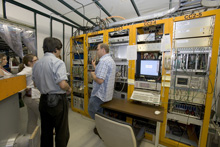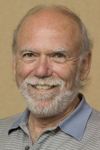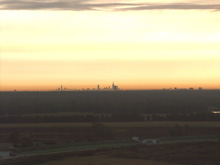 |
Friday, September 22
3:30 p.m.
DIRECTOR'S COFFEE BREAK - 2nd Flr X-over
4:00 p.m. Joint Experimental Theoretical Physics Seminar -
1 West
Title: "Observation of B_s mixing at CDF"
Speaker: C. Paus, MIT
Monday, September 25
1:00 p.m. Research Techniques Seminar - Curia II
Speaker: F. Gaede, DESY
Title: Simulation and Reconstruction Software for the ILC
2:30 p.m. Particle Astrophysics Seminar - Curia II
Speaker: S. Dodelson, University of Chicago/Fermilab
Title: Dark Matter vs. Modified Gravity
3:30 p.m. DIRECTOR'S COFFEE BREAK - 2nd Flr X-Over
4:00 p.m. All Experimenters' Meeting - Curia II
Special Topics: Tevatron Ionization Profile Monitor;
Observation of the b Baryon Σ b at CDF
Click here for a full calendar with links to additional information.
|



Friday, September 22
-Beef Pepper Pot
-Buffalo Chicken Wings
-Cajun Breaded Catfish
-Sweet & Sour Pork over Rice
-Honey Mustard Ham & Swiss Panini
-Assorted Slice Pizza
-Carved Turkey
Upcoming Menu
|
 |
Wednesday, September 27
Lunch
-Crepes w/Black Forest Ham and Gruyere
-Arugula and Sweet Red Pepper Salad
-Chocolate Mousse w/Butter Cookies
Thursday, September 28
Dinner
-Coquille St. Jacque
-Beef Kabob w/Vegetables
-Rice Pilaf
-Pecan Torte w/Bourbon Cream
Chez Leon Menu
Call x4598 to make your reservation.
|


|
 |
| Fermilab's ILC task force will enhance collaboration with university community
|
 |
|
ILC Test Area: Fermilab's Meson Detector Building is one of the new facilities
that will help Fermilab's user community participate in R&D activities.
|
|
|
As time marches closer to making a decision on siting and building the International Linear Collider, the number of scientists working on the project will have to dramatically increase. From the graduate student to the senior physicist, large numbers of scientists will have to be recruited to design, build and eventually operate the machine. Over the past year, particle accelerator schools have taught new students about the ILC, but other efforts beyond the classroom are also happening, such as Fermilab's ILC Task Force.
In May 2006, Fermilab Director Pier Oddone and Fermilab Deputy Director Young-Kee Kim appointed a broad cross-section of scientists to evaluate the lab's current plan for the ILC, to determine how to increase Fermilab scientists' participation in linear collider activities and enhance collaborations with the university community. "We wanted representation from all of the divisions at Fermilab, and we wanted to work with the particle physics community from the very beginning," Kim said. The task force membership includes 10 Fermilab scientists and 11 experts from SLAC, Argonne, and universities, who bring valuable insights into what the user community needs to effectively participate, such as enhancing facilities by providing test areas and computing abilities for detector and accelerator R&D.
Charged with writing a plan that outlines how to increase laboratory particle physicists' involvement in the ILC, the committee divided itself into four working groups to recommend specific ILC projects in which Fermilab scientists can collaborate with university groups. "Right now there are not enough Fermilab scientists involved with the ILC for what we are going to need in the future," said Fermilab's Mike Lindgren, who chaired the task force. "One good way to figure out what will attract people is to take physicists who are not involved and ask them that question. The more I learned, the more I realized the challenges for the ILC. Scientists like challenges."
Breaking with tradition, the task force selected young scientists to be the leaders for the four working groups: Accelerator, Beam Instrumentation, Detectors and Test Beam Facilities. Given a long list of questions, the working groups met on a regular basis to identify places where Fermilab physicists can get involved with the ILC. "There are huge lists of tasks out there that need to be done for ILC R&D," Lindgren said. "We have to think hard about what needs to be done and which things are well suited to our strengths and not being done already. We want to collaborate with others in the community to be good partners in making the ILC a reality."
The task force presented a preliminary report to the Fermilab Director on 15 July and plans to submit a final report this month. The task force's recommendations will be published in a public document later this year. "Establishing this kind of task force is tremendously insightful for motivating scientists," Lindgren said. "It gives them the opportunity to put their shoulders in the harness and pull."
--Elizabeth Clements
|

Berkeley Lab Research News, September 20:
The Weirdest Type Ia Supernova Yet
BERKELEY, CA - A group of scientists affiliated with the SuperNova Legacy Survey (SNLS) have found startling evidence that there is more than one kind of Type Ia supernova, a class of exploding stars which until now has been regarded as essentially uniform in all important respects. Supernova SNLS-03D3bb is more than twice as bright as most Type Ia supernovae but has much less kinetic energy, and appears to be half again as massive as a typical Type Ia.
Read More |
|  |

The Evolving ILC Design: Changing the Crossing Angles
|
| This column is written by Barry Barish, director of the Global Design Effort.
Optimizing cost to performance for the ILC design is a challenging task. Our working groups have identified a number of possible design changes,
 |
| Barry Barish |
motivated by large potential cost savings. Changing the crossing angles for the final focus interaction regions is one item that has been under discussion for some time now. Last fall, we adopted an ILC baseline that had two beam lines -- one with a crossing angle of 2mrad and the other with 20mrad. The design of the resulting beam delivery system staggered interaction points in two separate detector halls. Motivated by the significant cost savings, as well as lower risk, we recently decided to change the beam line configuration to having two beam lines with 14mrad crossing angles. It is a particularly notable change, because of the potential physics impacts, which had to be weighed against the cost savings and lower risk.
Read More
|

 |
| Skyline: Dave Huffman took this picture Wednesday at 8:00 a.m. from the 14th floor of Wilson Hall.
"At the bottom of the picture part of Main Ring can be seen with one of the service buildings," he writes. If you click the image to see the larger version, you can just make out the spires on the Hancock building and the Sears tower.
|
|

At the end of the month, Rocky Kolb, director of Fermilab's Particle Astrophysics Center will retire from his position and become chairman
 |
| Rocky Kolb |
of the Department of Astronomy and
Astrophysics at the University of Chicago.
"Rocky will still have a strong connection to Fermilab," said colleague Scott Dodelson, adding that the University of Chicago has a long-standing relationship with the Fermilab Particle Astrophysics Center. "He will continue to have an office
here, and we expect to see him frequently."
Kolb
joined Fermilab in 1983 when he co-founded the Theoretical Astrophysics
Group. Since then, he has mentored over 50 Research Associates, most
of whom now occupy faculty positions at top universities around the world.
He has written over 200 scientific papers, served on numerous committees
devoted to charting the course of future research in physics and
cosmology, organized dozens of conferences, and is generally recognized as
one of the founders of the field of Particle Astrophysics.
|
|

English country dancing
English country dancing will next meet on Sunday, September 24, at 2 p.m. in Kuhn Barn. The meeting date will change to the first Sunday of the month, beginning in November. Newcomers are welcome; partners and previous experience are not required. Please contact folkdance@fnal.gov or call 630-584-0825 or 630-840-8194.
Professional Development
New classes are always being added to the professional development schedule. For the most up-to-date course offerings, go to the web page.
Classifieds
New classified ads have been posted on Fermilab Today.
Upcoming Activities
|
|




